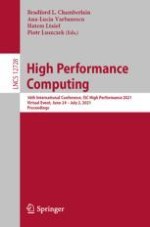2021 | Buch
High Performance Computing
36th International Conference, ISC High Performance 2021, Virtual Event, June 24 – July 2, 2021, Proceedings
herausgegeben von: Bradford L. Chamberlain, Ana-Lucia Varbanescu, Hatem Ltaief, Piotr Luszczek
Verlag: Springer International Publishing
Buchreihe : Lecture Notes in Computer Science
